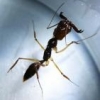Pogonomyrmex californicus aren't polygynous, and strictly have one entry hole per nest. The largest nests average around 2000+ workers.
They are dead now. But, the Pogonomyrmex (not 100% sure what species) that I could get to locally, acted all friendly with each other. They built up a bunch of irrigation and new apartments, so Argentine ants will have killed them off or will very soon. A ton more Argentine ants where they live.
But, I could take workers from one colony. Walk about 70 or so feet away (with no possible connection, colonies were completely separated by concrete) and the workers would be friendly with each other. The sand only goes down a few inches, so it was very easy to get them. Its built on top of a concrete drainage system, that allows a river to flow through during the rains. They used dump trucks to pile sand on top of the concrete, but it isn't deep at all.
In fact, I kept a bunch and at one time had quite a few queens living with each other. I got them when they had their mating flight, and put a bunch of workers with them. Some of the queens got kicked out, but out of 10 total queens, 6 stayed in the colony. Though I thought we were moving, so gave them to my friend down in San Diego. Though they died on him because Argentine ants came in (billions of them where he lives), but he said during the entire month he had them, they still always had 6 queens.
Maybe not Pogonomyrmex californicus, but they had an interconnected colony or were at very least, very accepting of each other.
Too bad they are gone or will be gone soon. Maybe I should go check them and see if I can't get any, before the Argentine ants solidify their holding of the area. I've just assumed they died by now.
Edited by Vendayn, January 2 2017 - 4:03 PM.


















